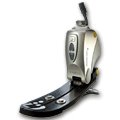 I have seen the future -- and it's bionic.
I have seen the future -- and it's bionic.Today here in Reykjavik I visited the headquarters of Ossur, the prosthetics company responsible for the Cheetah foot which I'll use to run the half marathon tomorrow.
But if you think the Cheetah's a clever piece of kit, wait till you see what's on the horizon.
Ossur's crack R&D team took me into the lab to try out the new Proprio Foot, which is just about to come to market.
It's an unbelievable piece of technology.
The problem with below-knee prostheses at the moment is that the angle of the "ankle" and "foot" is fixed. That's fine on flat ground, but on rolling terrain or stairs it means the rest of your body has to work extremely hard to compensate for the unchanging angle of the foot.
The Proprio, however, has a built in computer and what are called "accelerometers."
Put simply, the computer constantly analyses the foot as it moves through space. It's able to recognise when the user is walking on flat or sloped surfaces, or up and down stairs, and a built in motor adjusts the angle of the foot accordingly.
The result is that rather than fighting to compensate for the limitations of a traditional prosthesis, the Proprio responds to changing terrain and makes walking a whole lot more natural. Best of all, it does the thinking for you. It responds automatically and almost without you noticing.
Unfortunately, I had to give my trial model back, which I did with great reluctance. But you can be sure that when the Proprio does go on sale I'll be raiding the piggy bank and joining the queue.

0 Comments:
Post a Comment
<< Home